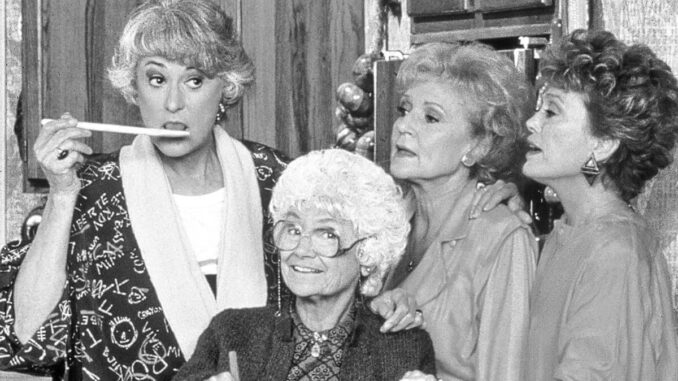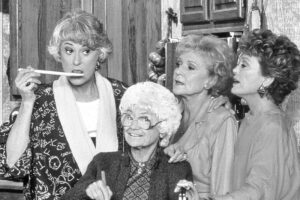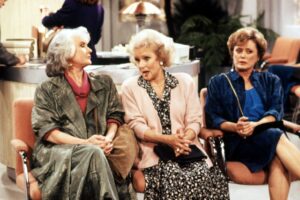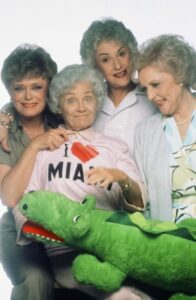
Every morning, even before he has breakfast, Elliott Powell starts his day with four piano chords and a sunny view of Miami ushering in another rerun of “The Golden Girls.”
“They’re just part of my routine,” said Powell, who teaches gender studies at the University of Minnesota, and has a shrine of photographs from the show on his office wall.
To the delight of die-hard fans, the 1980s sitcom about four female roommates living it up in South Florida during their golden years has been airing in blocks on cable channels — mostly those geared to women, baby boomers and gays and lesbians — for years. (Powell gets his daily dose from the Hallmark Channel.)
But now the show is available for 24/7 streaming on Hulu, priming a new generation of fans to join those who have been obsessed for years.

Since the show ended in 1992 (with an estimated 27.2 million watching the finale), it has repeatedly cycled back into popular consciousness, in large part thanks to fans. Target recently offered limited edition “Golden Girls” action figures, which quickly sold out. Betty White got her gig hosting “Saturday Night Live” after an audience-driven social media campaign. A new “Golden Girls” cafe is soon to open in New York City.
All around the world, fans continue to get together to watch the show or dress up like the characters in it.
Powell, 31, isn’t even that extreme as “Golden Girls” fans go — even if he did celebrate the defense of his dissertation by splurging on a copy of actress Rue McClanahan’s “Golden Girls” contract from an estate sale.
Now with its entree into streaming television, fans are feeling validated that the show they’ve long loved is getting yet another push into the spotlight.
“It’s been fun to watch the rest of the world figure out that ‘Golden Girls’ was amazing,” said Bradley Traynor, a self-described “super fan” and co-host of a Twin Cities radio show.
Starring television royalty, including Bea Arthur and Betty White, “The Golden Girls” ran from 1985 to 1992 on NBC. At the time, its success was like “lightning in a bottle,” said Jim Colucci, author of “Golden Girls Forever: An Unauthorized Look Behind the Lanai.”

Everything from the venerated cast and the edgy writing to the shoulder-padded nightgowns “all came together magically” to make an unexpected hit, he said.
It launched a trope seen on many shows since, in which four women with vastly different personalities act as a sort of surrogate family to one another. There was brainy Dorothy (Arthur), flirtatious Blanche (Rue McClanahan), naive Rose (White) and wise Sophia (Estelle Getty). All of them were bitingly funny and overtly sexual, a rare depiction of women of a certain age, both then and now.
“It was subversive that they dated a lot,” said Kevin Murphy, a professor of history at the University of Minnesota, who hopes to develop a course on the show with Powell. “The characters were unabashedly sexual and inhabited bodies that were not supposed to be sexual,” he said.
“Sex and the City” inherited the four-girlfriend formula, with Lena Dunham’s “Girls” following suit. But while these shows are tied to their audiences of 30-something romantics and aspirational hipsters, respectively, the enduring “Golden Girls” continues to pick up fans across multiple generations.
“Every time the show goes to a new platform, more people get into the habit,” said Colucci. “For a classic show, it’s a great thing for a new audience to find it and appreciate it in a new way.”
And it’s rare for a show to find an audience among various generations. Only “I Love Lucy” achieved a similar feat, Colucci said.

For many fans, the show’s ability to confront the social and political issues of the 1980s helped them see themselves on screen. The characters frequently addressed issues of the day head-on, including ageism, poverty and HIV/AIDS. By having empathetic, older women sharing their views, hot-button issues became relatable to diverse swaths of viewers, Colucci said.
“It seems every audience, particularly minority audiences, all feel like the show was made for us — even if it was about four old white ladies — because they are so personal and coming from a place of love,” he said.
Powell was born the year the show premiered, and he first watched it in reruns with his mother.
“As I got older, I would notice things going on in the show,” he said, “like how the show re-imagines the notion of family.”
During the Reagan era, when a family meant dad, mom and the kids, people who lived outside of the norm saw themselves reflected on a show in which men consist
ently played second fiddle to independent, single women, Powell said.
For gays and lesbians, especially, the show served as a kind of validation that family could be nontraditional, and chosen. In one episode, Rose has heart surgery, and the other women aren’t allowed to see her in the hospital because they are not related to her. Their frustration mirrored that of same-sex partners at the height of the AIDS epidemic who could not visit their loved ones in hospitals.
Traynor, 41, who was a kid during the first run, came to view the characters as “my TV aunts” who were there to guide him as he discovered his sexuality.
“Being a gay kid in the closet and trying to figure out what that meant, ‘The Golden Girls’ spoke to me in a way,” he said. “They were speaking to me at that young age about speaking your mind, living your true self.”
He would return to his TV aunts years later for their comfort and guidance.
“I got sober in my late 20s, and one of the things that kept me alive at that time would be to put in a DVD of ‘The Golden Girls,’” Traynor said. “That would be my security blanket.”
